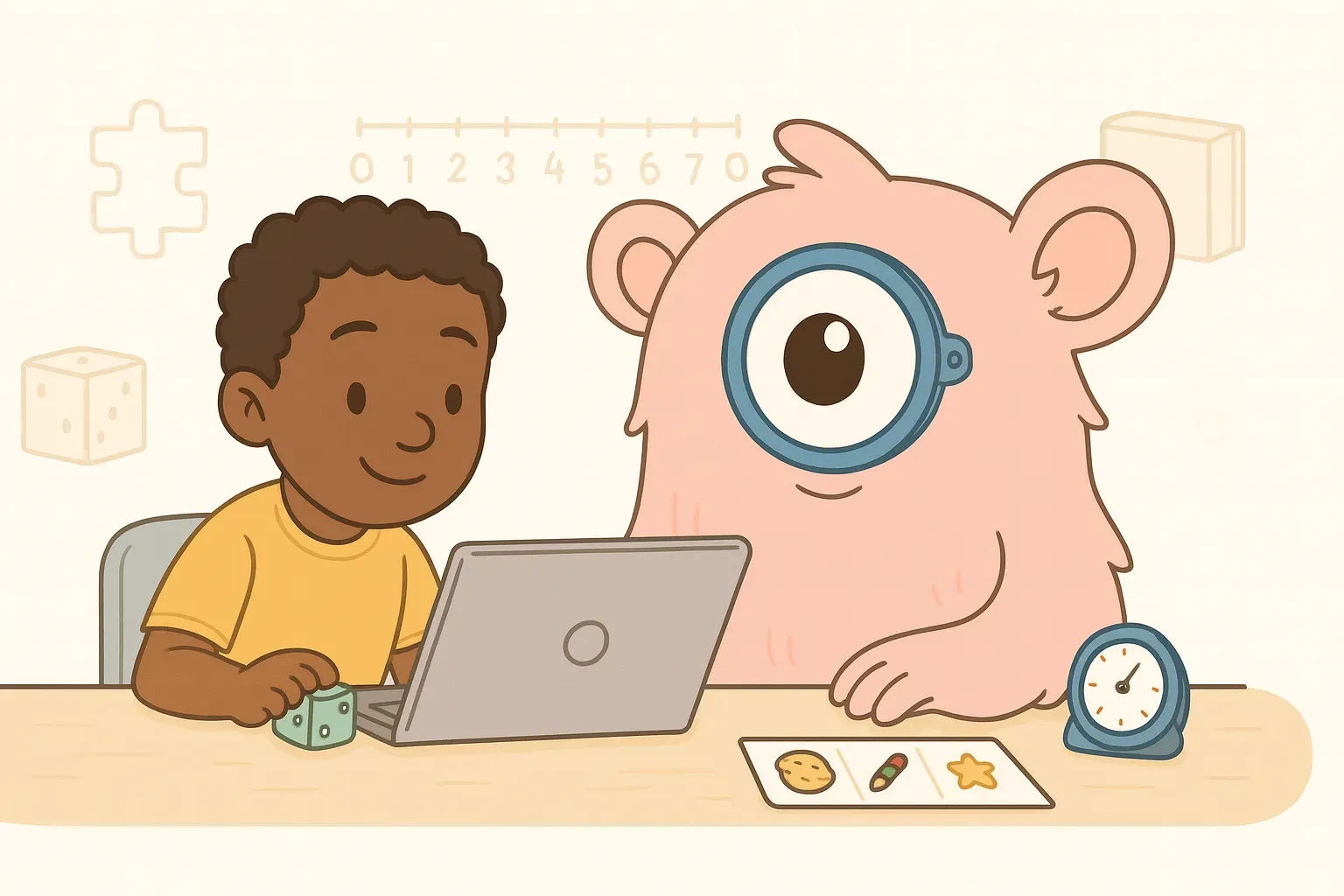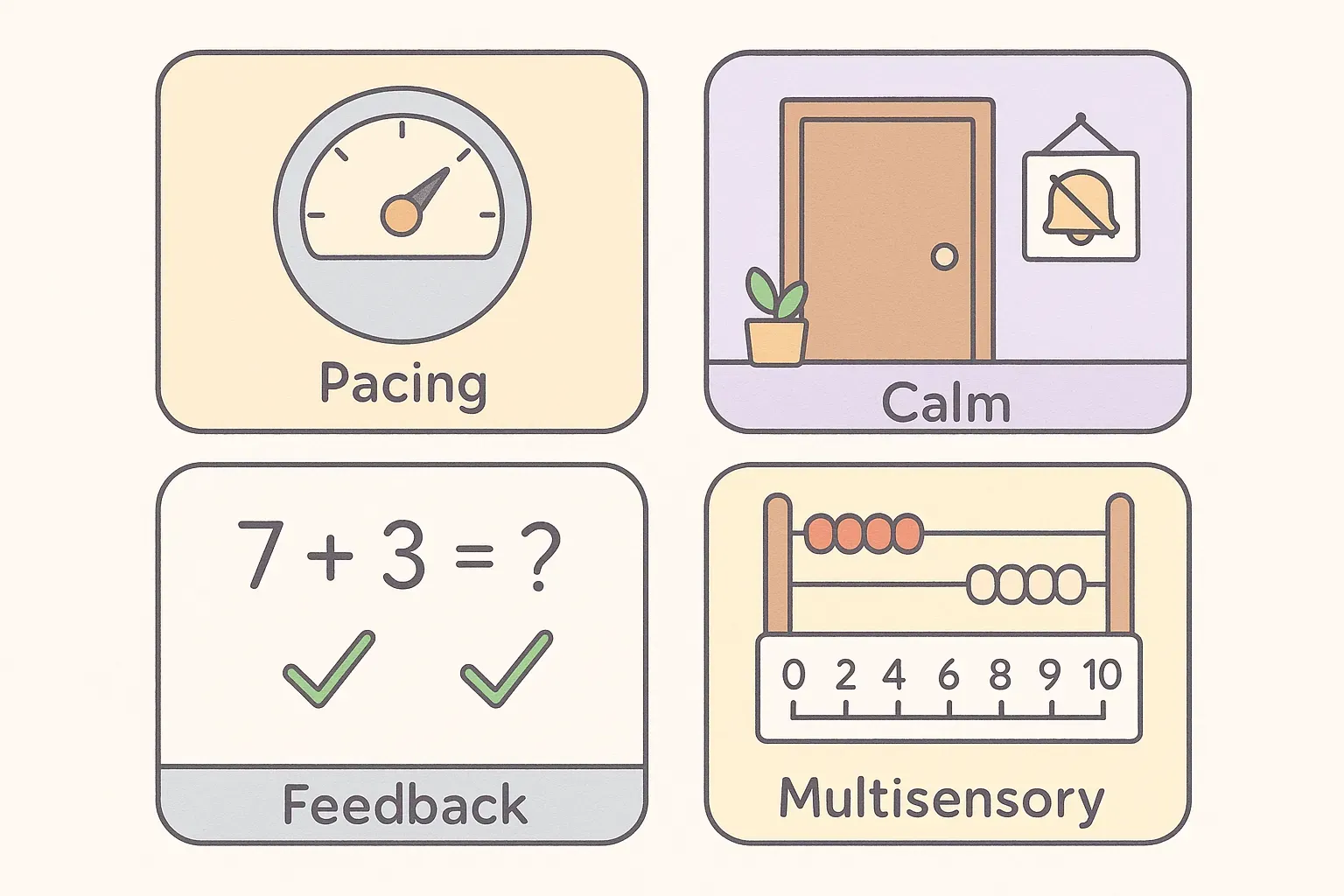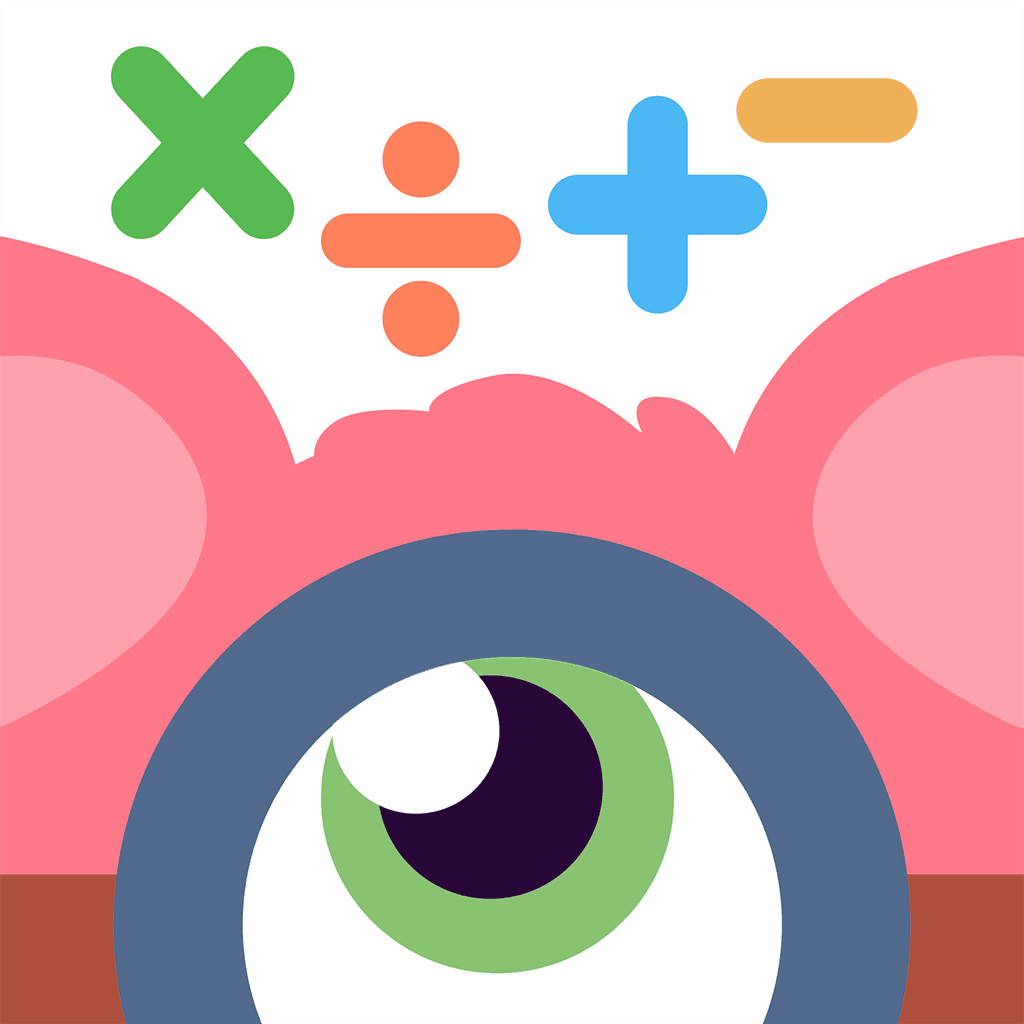5 Best Tutoring Options for US Kids with ADHD, Autism, or Dyscalculia
TL;DR: This guide is for U.S.-based parents of elementary-aged children who learn differently. It explains why one-on-one tutoring can be effective for neurodivergent learners and compares five strong tutoring options.
Why 1:1 Tutoring Helps Neurodivergent Kids

High-quality tutoring is one of the most effective interventions in K-12 education. Rigorous meta-analyses find large, consistent gains from tutoring programs across grades and subjects, with especially strong effects when sessions are frequent and individualized (Nickow, Oreopoulos & Quan, 2020; Nickow et al., 2024). For neurodivergent learners, the 1:1 format allows the tutor to match pace, reduce distractions, and use multi-sensory strategies that fit the child’s profile.
- Personalized pacing & methods - tutors adapt delivery (visuals, manipulatives, structured routines) to your child.
- Calmer learning space - fewer stimuli helps kids with attention or sensory needs focus.
- Immediate feedback & confidence - rapid correction and positive reinforcement build momentum.
- Targeted supports - e.g., number-sense scaffolds for dyscalculia; executive-function coaching for ADHD.
Context: In recent national data, about 11% of U.S. children have ADHD (Danielson et al., 2024; see also CDC ADHD data), approximately 1 in 31 eight-year-olds have autism (CDC ADDM, 2022 cohort), and dyscalculia affects an estimated 5–7% of the population (Göbel et al., 2022).

Top 5 Tutoring Options (Elementary • U.S.)
1) Brighterly - Online 1:1 Math & Reading (Grades 1-9)
OnlineMath +Reading,ADHD-friendly,Dyslexia/Dyscalculia-aware
Brighterly math and reading program specializes in engaging, one-to-one math and reading instruction for Grades 1–9 with a personalized learning plan after a free first lesson. The homepage highlights service for kids from 1st through 9th grade and explicitly welcomes learners with ADHD/dyslexia, noting tutors “deal with each individual situation”.
- Subjects/levels: Math & Reading, Grades 1-9 (site).
- Neurodiversity features: patient, individualized pacing; interactive, visual activities (site).
- Pricing: plans from about $17.4 per live class (pricing).
- Format: live 1:1 online; free demo lesson.
- Best for: Elementary parents seeking a structured, game-based math/reading plan that adapts to ADHD or dyscalculia.
2) Lindamood-Bell — Evidence-Based Reading & Math (On Cloud Nine®)
In-person,Online,K–12,Dyslexia,Dyscalculia,Autism-aware
Lindamood-Bell operates U.S. learning centers and provides live-online one-to-one instruction. For math, its On Cloud Nine® program develops concept and numerical imagery to support reasoning and computation—helpful for students with dyscalculia. Instruction is individualized and available both in centers and live online. (On Cloud Nine®; locations & live-online).
- Subjects/levels: Reading, comprehension, spelling, and math; K–12.
- Neurodiversity features: evidence-based programs; one-to-one instruction; options suited for dyslexia, ASD, and dyscalculia.
- Pricing: via consultation; intensive blocks available.
- Format: in-center or live-online 1:1.
- Best for: Families seeking research-validated, intensive intervention for reading or math foundations, especially if they prefer in-center.
3) Special Ed Resource — Certified Special-Education Focus
OnlineSpecial Education,ADHD,Autism,Dyscalculia
Special Ed Resource matches students with experienced special-education tutors nationwide and emphasizes individualized plans, session summaries, and family support (academics + strategies aligned to IEP/504).
- Subjects/levels: K–12 academics; targeted SPED supports (reading, math, study skills).
- Neurodiversity features: tutors with SPED training; individualized pacing and strategies (details).
- Pricing: via consultation (program-dependent).
- Format: live 1:1 online; parent progress updates.
- Best for: Children who need a certified SPED approach aligned with IEP/504 goals.
4) Huntington Learning Center — In-Center or Online, Structured Programs
In-person,Online,K–12, ADHD,Autism-aware
With centers nationwide and online options, Huntington offers a comprehensive model: diagnostic evaluation, customized plan, and regular progress reviews. Their ADHD program highlights individualized one-to-one instruction and an extensive training process developed by a clinical psychologist for tutors who work with ADHD learners (ADHD tutoring page).
- Subjects/levels: Reading, writing, math, study skills; K–12; test prep.
- Neurodiversity features: structured, multi-sensory strategies; parent/teacher coordination.
- Pricing: varies by evaluation & program package.
- Format: in-center or online, always 1:1 instruction.
- Best for: Parents wanting a highly structured plan with face-to-face option.
5) Varsity Tutors — Large Network with Special-Needs Filters
Online3,000+ subjectsADHDAutismExec-function
Varsity Tutors connects families to a large pool of instructors; you can request tutors with backgrounds in special education or experience supporting ADHD and Autism (Autism, ADHD). Flexible scheduling and breadth of subjects are key strengths; pricing is quoted based on package and tutor.
- Subjects/levels: Broad (incl. elementary literacy/math).
- Neurodiversity features: request tutors with SPED/ABA/exec-function expertise; special classes available.
- Pricing: varies; package/hourly quotes.
- Format: live 1:1 online (group options exist, but 1:1 is recommended for attention needs).
- Best for: Families who want maximum choice to find a very specific tutor profile.
Quick Comparison
Side-by-side overview for elementary-age needs
Service | Format & Grades | Core Subjects | Neurodiversity Support | Starting Cost | Good Fit For… |
|---|---|---|---|---|---|
Brighterly | Online 1:1; Grades 1–9 (site) | Math & Reading | ADHD/dyslexia/dyscalculia-aware; personalized plan | ~$17.4 per class (pricing) | Affordable, structured math/reading growth |
Lindamood-Bell | In-center or online 1:1; K–12 | Reading, Comprehension, Spelling, Math | Evidence-based programs; suitable for Dyslexia, ASD, Dyscalculia | Consult for quote | Intensive, research-validated intervention |
Special Ed Resource | Online 1:1; K–12 (nationwide) | Reading, Math, Study skills; IEP support | SPED-trained tutors; individualized reports | Consult for quote | IEP-aligned SPED instruction |
Huntington Learning Center | In-center or online; K–12 | Reading, Writing, Math; Test prep | ADHD tutor training; structured, multi-sensory | Varies by program | Families wanting face-to-face + structure |
Varsity Tutors | Online 1:1; K–12+ | 3,000+ subjects | Filters for ADHD/Autism/exec-function | Varies (package/hourly) | Wide selection / niche expertise |
Pricing and availability can change; verify current offers on each provider’s site.
FAQs
How do I know if a tutor is the right fit for my child?
Look for relevant experience with ADHD/Autism/Dyscalculia, strong parent reviews, and a willingness to adapt methods (visuals, manipulatives, short tasks with breaks). Many providers offer trial sessions (e.g., Brighterly demo). After 2–3 sessions, you should see growing comfort and clearer routines.
Is online tutoring effective for kids with ADHD or Autism?
Yes - especially in 1:1 sessions. Meta-analyses show tutoring substantially improves learning outcomes (Nickow et al., 2020). Online can reduce sensory load (home environment) and allows screen-based visuals. If your child needs in-person scaffolds or has screen fatigue, consider a hybrid approach or an in-center option like Huntington or Lindamood-Bell.
Should tutoring replace school services (IEP/504)?
No - think complement, not replacement. Tutoring provides intensive, individualized practice; IEP/504 ensures classroom access and accommodations. Services like Brighterly, Special Ed Resource, Huntington, or Lindamood-Bell will coordinate with parents/teachers to align goals.
What progress should I expect - and how soon?
For foundational skills (e.g., number sense, decoding), expect incremental gains within weeks when sessions are frequent (2–3x/week is ideal), with larger term-over-term growth. Dyscalculia often requires explicit, multi-sensory instruction and patient fluency-building - progress is real, but it’s a marathon, not a sprint (Göbel et al., 2022).
Can insurance cover tutoring? What about IEP funds?
Insurance rarely covers academic tutoring. However, some states’ education savings accounts (ESAs) or district programs may fund tutoring, and IEP teams can sometimes integrate after-school supports. Ask providers about scholarships/financial aid.
What if tutoring is too expensive for me?
You can always consider using self-paced programs like Monster Math. It won't be the same as a trained teacher doing 1:1 coaching - however the fun and self-paced bits of such programs can help provide enough learning and practice in many topics and you can then focus on areas where they explicitly need help or face a bottleneck.
References
- Nickow, A., Oreopoulos, P., & Quan, V. (2020). The Impressive Effects of Tutoring on PreK–12 Learning (NBER Working Paper No. 27476). PDF.
- Nickow, A., Oreopoulos, P., & Quan, V. (2024). The Promise of Tutoring for PreK–12 Learning. Article.
- Danielson, M. L., et al. (2024). ADHD prevalence using 2022 NSCH. PubMed. See also CDC ADHD data: CDC.
- CDC ADDM Network (2025). Autism prevalence (2022 cohort): ~1 in 31 eight-year-olds. MMWR report.
- Göbel, S. M., et al. (2022). Dyscalculia overview with 5–7% prevalence estimate. PMC.
- Provider sources — Brighterly overview & grades: site; pricing from ~$17.4/class: pricing. Lindamood-Bell On Cloud Nine® math: program; centers & live-online: locations. Special Ed Resource: site and special-needs tutoring. Huntington ADHD tutoring & training: page. Varsity Tutors learning differences: LD hub, ADHD, Autism.

